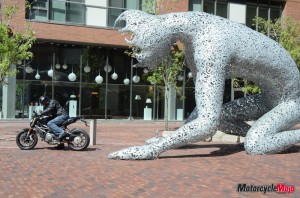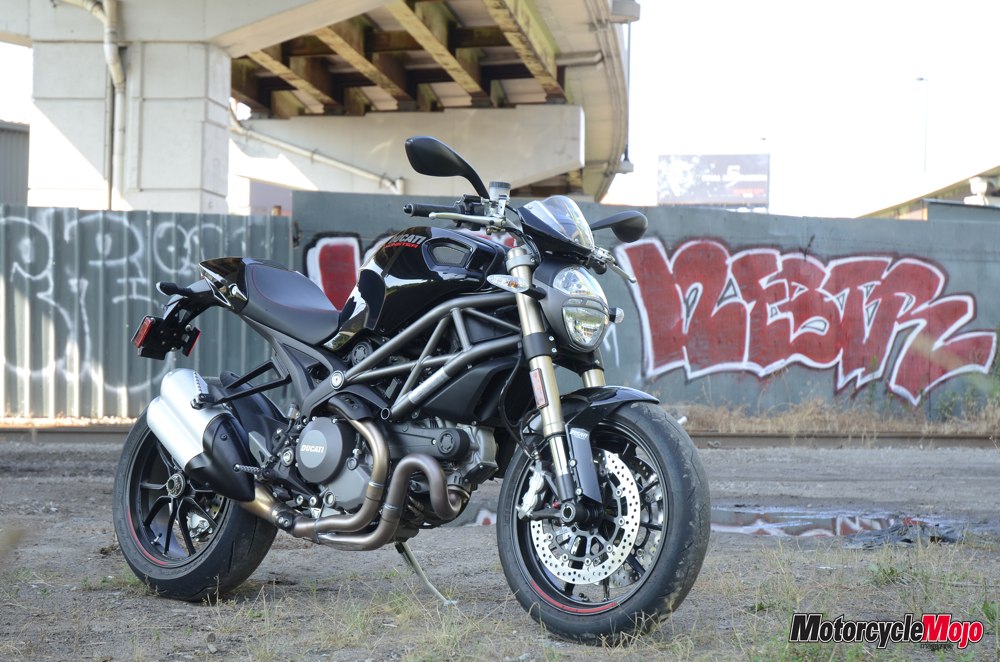The low rumble that found its way through the open kitchen window interrupted the conversation I was having with my wife’s friend. “What is that noise?” she asked, her tone clearly indicating that the stumbling din had become an annoyance. “Oh, it’s just a Monster,” I nonchalantly replied. With narrowed eyes she said, “Very funny. Seriously what is making that noise?”
I had forgotten that for the uninitiated, monsters are fictional creatures that evoke a sense of terror because of their evil and hideous nature. Society’s more popular monsters have become legendary and are often portrayed in horror films and books. Motorcyclists, on the other hand, see Monsters in an entirely different light. One model year short of a twentieth anniversary, Monsters are legendary because of their longevity in Ducati showrooms.
There are actually two Il Mostro in my neighbourhood, both of them 696 Monsters equipped with loud aftermarket exhausts, one of which is inexplicably always left to idle for a good ten minutes before every ride by its owner. And although the 696 represents a good value, baby Monsters tend to grow up to become even more formidable machines, such as the 2012 Monster 1100 EVO.
Ducati describes the 1100 EVO as being the ultimate Monster – a full evolution of the model range’s flagship bike. Especially considering its 1079 cc displacement, the motorcycle is impossibly small and compact in appearance. Despite being nothing more than a pair of wheels coupled to a frame with an engine, the 1100 EVO looks menacing, and its purposeful stance is an eye-pleasing interpretation of the standard motorcycle genre.
The view from the top is equally surprising. The full-sized Monster disappears beneath a rider much like a unicycle between the ass cheeks of a fat man, providing a rider with the confidence that he will be able to manhandle the machine with ease. Even more reassuring is its lack of weight; the 1100 EVO is claimed to be 169 kg (dry), making it the lightest in its category.
At the core of its minimal design is a signature Monster component, a lightweight trellis frame constructed from tubular steel and coupled to an aluminum rear sub-frame. Aluminum alloy wheels and a chill-cast aluminum single-sided swingarm further contribute to the bike’s lithe character. Up top, what appears to be the fuel tank is actually a plastic shroud housing the airbox and its associated plumbing, along with the actual fuel tank. Completing the updated look is the redesigned rear of the bike, which is now sharper and more skeletal in appearance.
Ducati states that the changes made to the bike’s ergonomics were in part based on feedback from Monster owners. In other words, owners complained and Ducati listened, reshaping the bike’s seat and increasing the handlebar riser’s height by 20 mm to improve rider comfort.
The 1100 EVO is a more tolerable machine to spend time on, but its multi-function instrumentation sits low and forces taller riders to tilt their heads down to read. Once you’re looking down, the minimal instrument panel is easily read, even in direct sunlight, and provides far more than just the essentials. Additional data is accessed by using the left handlebar–mounted MODE switch, which reveals scheduled maintenance reminders, oil temperature, ABS and traction control settings, battery voltage and a lap timer. As with every Monster, the 1100 EVO is ready for Ducati’s data acquisition system (DDA). The optional DDA allows riders to record the bike’s performance on a memory key, which incidentally plugs into the same underseat slot used by the battery tender, another Ducati option for the bike.
Despite its apparent complexity, the instrumentation is both intuitive and easy to use. However, there is one glaring omission; the bike doesn’t have a fuel gauge. Undoubtedly, 1100 EVO owners will become familiar with the fuel range of their machines, and even though the bike does have a low-fuel warning light and a reserve fuel odometer, nothing replaces being able to check a fuel gauge when approaching a gas station while on a long-range ride.
For a naked motorcycle, there’s less of the engine to see than you would expect with much of its big-barrelled beauty obscured by the bike’s frame and exhaust. Nonetheless, the Desmodue Evoluzione engine is the source of the bike’s name and is Ducati’s first air-cooled 2-valver to break the 100 hp mark. Claimed to produce 73.5 kW (100 hp), this Desmo may represent the pinnacle of three decades of development, but it’s also an engine that likes being juiced. It might seem counterintuitive to have to keep a big twin on boil, but that’s the secret to riding this big Monster quickly.
Under 4000 rpm ,the Desmo shudders under demand; the handlebar ends hop up and down, the images in its mirrors blur, and its fuelling feels like you’re holding back a pack of ravenous wolves that are really unhappy maintaining a pedestrian pace. Essentially, the engine is telling you to get your thumb out and pick up the pace. In practice, there’s a sweet spot between 4000 and 9000 rpm, with 5000 being the ideal spin rate from which anything is possible.
Ducati’s modifications to the engine include the use of vacuum-cast crankcases, a new magnesium alternator cover, a lightened crankshaft assembly, and a flywheel similar to that used in Ducati’s 848. The cylinder head’s lubrication and cooling performance was also improved, and its inlet ports were reshaped for better flow. The combination of a modified combustion chamber and a compression bump from 10.7 to 11.3:1 allowed Ducati to swap the previous dual spark system for a single plug per head.
The Monster’s new 2-1-2 exhaust system uses a dedicated lambda probe in each header and a mid-section valve to regulate exhaust pressure. The pipes have been rerouted through the machine on their way to the vertically stacked catalyzed silencers that ensure the Ducati meets Euro 3 exhaust standards. The note from the new exhaust system is muted – too much for an exotic Ducati. Although the rest of the neighbourhood, especially those conversing in kitchens, will appreciate the socially responsible OEM exhaust, hardcore Ducatistas will want a more stirring soundtrack for their ride.
Along with a rider’s right hand, the engine’s output is governed by Ducati’s Dynamic Traction Control system (DTC), which on the 1100 EVO has a more limited range of adjustment than on some of the other Ducati models. That’s a good thing. Street riding doesn’t require an overly complex traction control system; you either want to allow some wheel spin or none at all. On the big Monster, the four-level DTC provides the greatest safety when switched to 4, where it will react to the slightest wheel spin. Conversely, when set to 1, DTC will allow competent riders to light up their rear wheels.
The system uses front and rear wheel sensors to keep an eye on how fast they’re turning, and intercedes when the rear tire spins faster than the front. DTC uses two methods, sometimes in combination, to reign in a malevolently spinning rear wheel. The less intrusive interaction uses high-speed software to adjust the ignition timing and reduce the engine’s torque. If the wheel continues to spin, DTC becomes more aggressive with its timing adjustments, and if required, can also begin a series of constantly increasing fuel-injection cuts, all the way to a full injection cut. Two warning lights normally used to indicate that you’ve hit the over-rev limiter will illuminate when the DTC is in use. Not only does this all happen faster than you can think, but Ducati boasts that the process is also seamless.
As expected with a Ducati transmission, the top two of the 1100 EVO’s six gears are overly tall. This forces riders to treat the gearbox as if it was a four-speed with two overdrive ratios; sixth gear isn’t of much use unless you’re riding much faster than the posted limit on highways. Irrespective of this quirk, the transmission performed flawlessly and the clutch action was relatively light for a big-displacement bike, in part because the 1100 EVO’s slipper-clutch uses a progressive self-servo mechanism that presses the clutch plates together when under drive from the engine, allowing for lower clutch spring rates and providing a lighter clutch action.
Of course, the Monster’s ample get-up-and-go performance and high-tech wizardry wouldn’t amount to anything if the bike couldn’t effectively turn a corner. Fortunately, the bike’s suspension is superb in relaying exact details about the road’s surface, and is well tuned for the demands of sport riding. Taking credit for the light and razor-sharp handling is a fully adjustable 43 mm Marzocchi fork and a Sachs rising-rate rear shock, which is adjustable for preload and rebound damping. The steeply angled shock is compressed in a non-linear manner to the swingarm’s arc of movement to give it a progressive performance. This design not only allows for easier access to the shock for adjustments, but it also saves weight.
The 1100 EVO introduces the Ducati Safety Pack (DSP) to the Monster line-up. DSP consists of the aforementioned DTC and a Brembo-Bosch ABS system, which can be switched off by the rider. Imposing even in appearance, the front Brembo brakes appear to be almost as large as the front wheel and match expectations by providing tire-blistering performance. Radial pumps contribute to the brakes’ power and precision, while the adjustable levers enhance their control.
It seems misleading to call this motorcycle, with its quality accoutrements, sophisticated build quality and refined characteristics, a Monster. Even its purchase price ($13,495) and upkeep (the 1100 EVO has 12,000 km service intervals to ease long-term maintenance costs) are rather civil. The 2012 Monster 1100 EVO is a motorcycle that only begins to live up to its name when it’s let out of its cage. Ignore the rules – and morality – governing the operation of a vehicle on public roads, and you will quickly discover just how much of a Monster the 1100 EVO really is. At its core is an engine that detests low revs, a fuelling system that loathes indecision, a suspension package that mocks timid riding and brakes that could stop a rotating planet. It is a machine that rewards monstrous behaviour, and it’s not until you ride one in anger that you will understand what it is all about. Owners of older and smaller Monsters who buy the full-pop EVO will already know this: the harder you ride a Monster, the better a motorcycle it becomes.
| MODEL | 2012 Ducati Monster 1100 EVO |
| List Price | $13,495 |
| Warranty | 2 years |
| Engine Type | Air cooled, SOHC, 4-valve, 90-degree L-twin |
| Displacement | 1079 cc |
| Power (claimed) | 73.5 kW (100 hp) at 7500rpm |
| Torque (claimed) | 103 N-m (76 ft-lb) at 6000 rpm |
| Bore and Stroke | 98 x 71.5 mm |
| Compression Ratio | 11.3:1 |
| Fuel Delivery | Siemens EFI, 45 mm throttle body |
| Transmission | 6-speed |
| Final Drive Type | Chain |
| Front Suspension | 43 mm inverted Marzocchi fork with adjustable preload, compression and rebound damping |
| Rear Suspension | Sachs progressive monoshock with adjustable preload and rebound damping |
| Wheel Travel | 130 mm (5.1 in.) front; 148 mm (5.8 in.) rear |
| Brakes | Front: Two 320 mm discs with radially mounted 4-piston calipersRear: One 245 mm disc with 2-piston caliper |
| Wheelbase | 1450 mm (57.1 in.) |
| Rake and Trail | 24 degrees/96.5 mm |
| Tires | 120/70-17 front; 180/55-17 rear |
| Weight (dry) | 169 kg (373 lb.) |
| Seat Height | 810 mm (31.9 in.) |
| Fuel Capacity | 13.5 L |
| Fuel Economy (observed) | 6.26 L/100 km (45 mpg) |
| Fuel Range (estimated) | 216 km |


































































